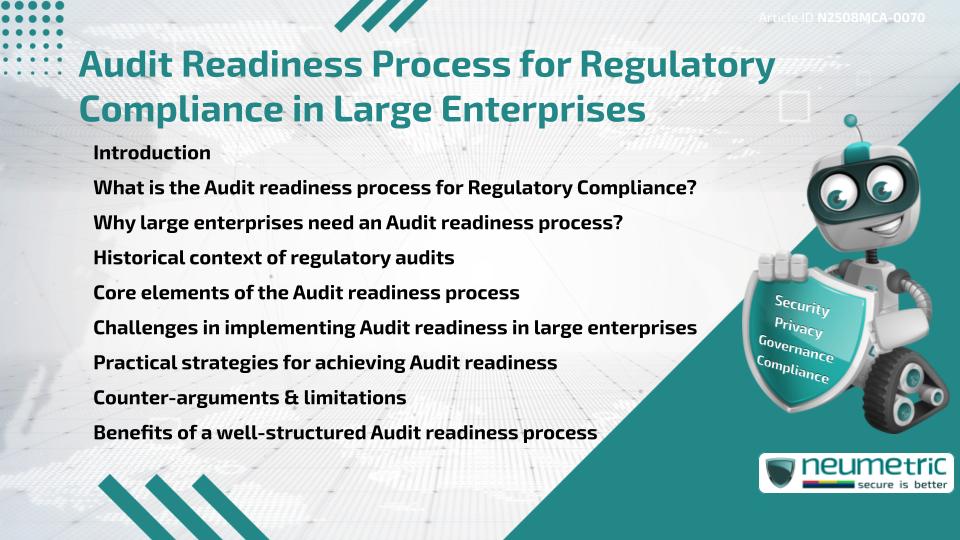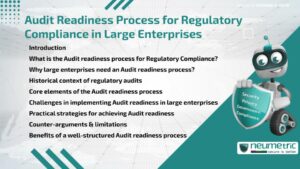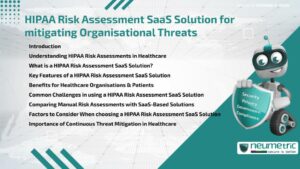Table of Contents
ToggleIntroduction
The Audit readiness process for Regulatory Compliance is essential for large enterprises operating in industries with strict rules & oversight. It involves preparing Policies, procedures & Evidence to demonstrate adherence to relevant regulations such as Data Protection, Financial reporting & workplace safety. This process reduces the Risk of penalties, enhances transparency & builds trust with regulators & Stakeholders. Large Organisations, due to their scale & complexity, often face heightened scrutiny, making structured readiness a crucial element of corporate Governance. This article explains the meaning, history, components, challenges & benefits of the Audit readiness process for Regulatory Compliance in large enterprises.
What is the Audit readiness process for Regulatory Compliance?
At its core, the Audit readiness process for Regulatory Compliance is the systematic preparation that enables an organisation to demonstrate compliance during a regulatory Audit. It ensures that internal documentation, control systems & compliance frameworks are in place & functioning effectively. Think of it like an airline pilot’s pre-flight checklist: every switch, lever & gauge must be verified before takeoff to ensure safety. Similarly, Organisations prepare every control, policy & record so that nothing is overlooked during an Audit.
Why large enterprises need an Audit readiness process?
Large enterprises deal with multiple departments, regions & regulatory bodies. Without a structured process, compliance gaps can go unnoticed, leaving Organisations vulnerable to fines, reputational damage or even loss of licenses. The Audit readiness process for Regulatory Compliance provides a consistent structure that aligns diverse teams under a common Framework. It also promotes proactive Risk Management, as gaps are identified & corrected before Auditors raise concerns.
Historical context of regulatory audits
Regulatory audits have existed for centuries, beginning with Financial oversight in early trade & commerce. Over time, governments expanded regulations to cover labor rights, consumer protection & environmental laws. For example, the rise of corporate scandals in the early 2000s led to stricter Financial reporting rules under legislation such as the Sarbanes-Oxley Act. Similarly, the adoption of the General Data Protection Regulation [GDPR] in Europe emphasised Data Privacy & forced Organisations worldwide to rethink compliance. This history shows that the Audit readiness process for Regulatory Compliance is not just a modern requirement but the product of evolving business accountability.
Core elements of the Audit readiness process
The process generally includes:
- Policy & procedure documentation: Creating clear records of compliance activities.
- Internal controls testing: Verifying that processes prevent errors or misconduct.
- Risk Assessments: Identifying where compliance may fail.
- Training & awareness: Ensuring staff understand their compliance responsibilities.
- Evidence collection: Maintaining Audit trails to support compliance claims.
- Management reviews: Periodically checking the readiness status before external audits.
Challenges in implementing Audit readiness in large enterprises
Despite its importance, implementing an Audit readiness process for Regulatory Compliance in large enterprises is challenging. Common difficulties include fragmented systems, inconsistent data collection, lack of communication between departments & rapidly changing regulations. For instance, multinational corporations often need to align compliance with diverse legal frameworks across countries, which adds complexity. Additionally, resource allocation can be an obstacle, as readiness requires ongoing investments in training, technology & skilled staff.
Practical strategies for achieving Audit readiness
Large enterprises can overcome these challenges through several practical approaches:
- Centralised compliance management systems: Unifying data & processes for greater visibility.
- Regular mock audits: Conducting internal simulations to identify gaps before real audits.
- Cross-functional collaboration: Bringing together legal, Finance, HR & IT teams to align compliance efforts.
- Automation tools: Using technology to reduce human error & streamline Evidence collection.
- Clear accountability structures: Defining roles so that every compliance task has an owner.
Counter-arguments & limitations
Some argue that the Audit readiness process for Regulatory Compliance can become overly bureaucratic, consuming time & resources that could be directed toward business growth. Others note that readiness does not guarantee absolute compliance, as unforeseen events or new regulations can still expose Organisations to Risks. Moreover, small & medium-sized enterprises often consider such processes burdensome compared to their limited resources. While these points are valid, for large enterprises, the benefits of reduced penalties & improved reputation usually outweigh the costs.
Benefits of a well-structured Audit readiness process
A robust Audit readiness process for Regulatory Compliance delivers multiple advantages:
- Regulatory trust: Demonstrates commitment to following laws.
- Operational efficiency: Streamlines compliance processes & reduces duplication.
- Employee confidence: Staff feel more secure knowing roles are clear & compliance is maintained.
- Reduced Risks: Identifies & addresses issues before they escalate.
- Competitive advantage: Builds stronger relationships with partners, clients & regulators.
Takeaways
The Audit readiness process for Regulatory Compliance is not merely about passing audits. It is about embedding compliance into the culture of large enterprises. While challenges exist, structured preparation, technology & collaboration make the process both manageable & beneficial. Ultimately, Audit readiness is a shield that protects Organisations against Risks while enhancing their reputation.
FAQ
What is the main purpose of the Audit readiness process for Regulatory Compliance?
Its main purpose is to ensure that large enterprises can demonstrate compliance with regulations efficiently & consistently during an Audit.
How does Audit readiness benefit Employees in large enterprises?
It clarifies responsibilities, improves training & creates a culture of accountability, reducing uncertainty during audits.
Can Audit readiness eliminate all compliance Risks?
No, it cannot eliminate all Risks, but it minimises them by identifying issues early & implementing corrective measures.
What are examples of regulations that require Audit readiness?
Examples include GDPR for Data Protection, OSHA for workplace safety & Sarbanes-Oxley for Financial reporting.
How often should large enterprises conduct internal mock audits?
Enterprises typically conduct mock audits annually or semi-annually, depending on regulatory requirements & industry Risks.
Why is Evidence collection so important in Audit readiness?
Evidence provides tangible proof of compliance, such as reports, records & logs, which Auditors rely on to verify adherence.
Is the Audit readiness process costly for large enterprises?
While it requires investment in technology, training & staff, the cost is usually far less than the Financial & reputational damage of non-compliance.
Need help for Security, Privacy, Governance & VAPT?
Neumetric provides organisations the necessary help to achieve their Cybersecurity, Compliance, Governance, Privacy, Certifications & Pentesting needs.
Organisations & Businesses, specifically those which provide SaaS & AI Solutions in the Fintech, BFSI & other regulated sectors, usually need a Cybersecurity Partner for meeting & maintaining the ongoing Security & Privacy needs & requirements of their Enterprise Clients & Privacy conscious Customers.
SOC 2, ISO 27001, ISO 42001, NIST, HIPAA, HECVAT, EU GDPR are some of the Frameworks that are served by Fusion – a SaaS, multimodular, multitenant, centralised, automated, Cybersecurity & Compliance Management system.
Neumetric also provides Expert Services for technical security which covers VAPT for Web Applications, APIs, iOS & Android Mobile Apps, Security Testing for AWS & other Cloud Environments & Cloud Infrastructure & other similar scopes.
Reach out to us by Email or filling out the Contact Form…





